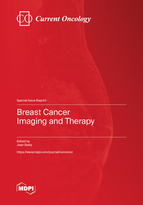Breast Cancer Imaging and Therapy
A special issue of Current Oncology (ISSN 1718-7729). This special issue belongs to the section "Thoracic Oncology".
Deadline for manuscript submissions: closed (1 October 2022) | Viewed by 54534
Special Issue Editor
Special Issue Information
Dear Colleagues,
In Canada, survival from breast cancer has steadily increased since 1989, and breast cancer mortality has decreased by 48% [1]. While 82% of women with breast cancer are diagnosed at stage 1 or 2, there are still 18% who present at a late stage and 25% who develop metastatic disease. Improved survival has been achieved through early diagnosis of breast cancer with screening, allowing more effective and targeted treatments. Significant gaps remain, however, where an early diagnosis of breast cancer in certain populations is not achieved, including women with dense breasts, those of Black (African), Asian, Indigenous, and Hispanic ethnicities, women aged 40–49 years not included in screening mammography programs, women at high risk who are 30 years and older, and men. We invite submissions of manuscripts to summarize the latest evidence on early detection of breast cancer and highlight areas where this may be improved.
Original research and reviews are welcome. Research areas may include (but are not limited to) the following: radiology, surgery, oncology, epidemiology, ethics, and public health.
Prof. Dr. Jean Seely
Guest Editor
Manuscript Submission Information
Manuscripts should be submitted online at www.mdpi.com by registering and logging in to this website. Once you are registered, click here to go to the submission form. Manuscripts can be submitted until the deadline. All submissions that pass pre-check are peer-reviewed. Accepted papers will be published continuously in the journal (as soon as accepted) and will be listed together on the special issue website. Research articles, review articles as well as short communications are invited. For planned papers, a title and short abstract (about 100 words) can be sent to the Editorial Office for announcement on this website.
Submitted manuscripts should not have been published previously, nor be under consideration for publication elsewhere (except conference proceedings papers). All manuscripts are thoroughly refereed through a single-blind peer-review process. A guide for authors and other relevant information for submission of manuscripts is available on the Instructions for Authors page. Current Oncology is an international peer-reviewed open access monthly journal published by MDPI.
Please visit the Instructions for Authors page before submitting a manuscript. The Article Processing Charge (APC) for publication in this open access journal is 2200 CHF (Swiss Francs). Submitted papers should be well formatted and use good English. Authors may use MDPI's English editing service prior to publication or during author revisions.
Keywords
- breast cancer screening
- dense breast tissue
- disparities







